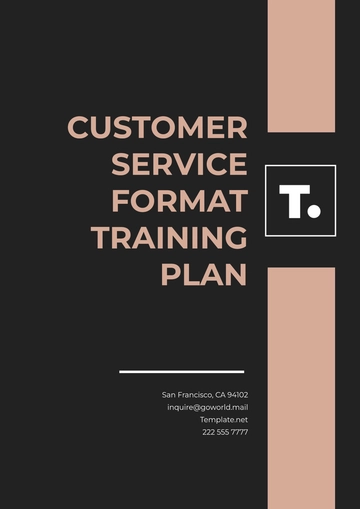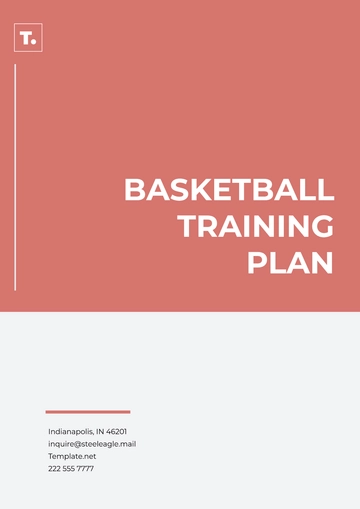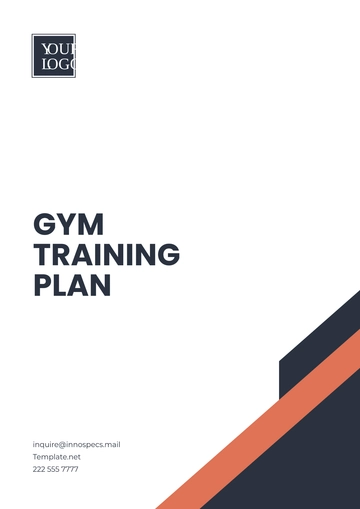Free Professional Personal Training Plan

Written by: [Your Name]
I. Introduction
This training plan has been carefully curated to cater to your individual needs, preferences, and objectives. Whether you're aiming to build strength, improve endurance, lose weight, or enhance overall fitness, this plan will guide you through a variety of workouts to help you succeed.
II. Training Objectives
Customized Workouts: Provide tailored workout routines based on your fitness level, goals, and preferences.
Progressive Overload: Gradually increase the intensity and challenge of workouts to promote continuous improvement and prevent plateaus.
Variety and Fun: Incorporate a diverse range of exercises and activities to keep workouts engaging, enjoyable, and effective.
III. Participant Information
A. Personal Details
Client Name: Garfield Williams
Email: garfield@you.mail
B. Health and Fitness Background
Age: 35
Current Fitness Level: Intermediate
Health Concerns/Medical Conditions: Mild lower back pain due to a previous injury; no other known medical conditions
IV. Training Schedule
A. Weekly Overview
Day | Workout | Description |
|---|---|---|
Monday | Strength Training | Focus on compound movements such as squats, deadlifts, and bench presses for full-body strength |
Tuesday | Cardio and HIIT | High-intensity interval training (HIIT) alternating between bursts of cardio and strength exercises |
Wednesday | Active Recovery or Yoga | Low-intensity recovery workout or yoga session to improve flexibility, mobility, and relaxation |
Thursday | Upper Body Strength | Target muscles in the upper body with exercises like push-ups, rows, and shoulder presses |
Friday | Rest and Recovery | Active rest day with light activities such as walking, stretching, or leisurely recreational activities |
B. Workout Details
1. Strength Training
Warm-up: Dynamic stretches and mobility exercises
Main Workout: 3 sets of 8-12 repetitions for each major muscle group
Cool-down: Static stretching and foam rolling
2. Cardio and HIIT
Warm-up: 5-10 minutes of light cardio (e.g., jogging, cycling)
Main Workout: HIIT circuit consisting of 30 seconds of high-intensity exercise followed by 30 seconds of rest, repeated for 20-30 minutes
Cool-down: 5-10 minutes of low-intensity cardio followed by stretching
3. Active Recovery or Yoga
Active Recovery: Gentle exercises such as walking, swimming, or cycling at a relaxed pace
Yoga: Flowing sequences to improve flexibility, balance, and mindfulness
4. Upper Body Strength
Warm-up: Shoulder and arm mobility exercises
Main Workout: Focus on chest, back, shoulders, and arms with a mix of free weights, machines, and bodyweight exercises
Cool-down: Gentle stretches for the upper body muscles
C. Progression and Adaptation
The training plan will evolve to ensure continued progress and adaptation to your changing fitness level and goals. Progression strategies may include increasing weights, adjusting repetitions and sets, incorporating new exercises, or modifying workout frequency and intensity.
V. Evaluation
A. Progress Tracking
Body Measurements: Tracking changes in weight, body fat percentage, and circumference measurements.
Performance Metrics: Monitoring improvements in strength, endurance, speed, and flexibility.
Subjective Feedback: Reflecting on energy levels, mood, sleep quality, and overall well-being.
B. Adjustments and Modifications
Based on progress assessments and feedback, the training plan will be adjusted as needed to address strengths, weaknesses, and areas for improvement. Modifications may include tweaking workout routines, adjusting intensity levels, or revising goals to ensure continued success.
Flexibility and adaptability are key components of a successful training program, and adjustments will be made to optimize your results and keep you on track toward achieving your fitness goals.
C. Support and Accountability
Continuous support and accountability are essential for maintaining motivation and staying on course with your training plan. Your trainer will provide ongoing guidance, encouragement, and expertise to help you navigate challenges, celebrate successes, and stay focused on your goals. Regular check-ins, progress reviews, and communication channels will ensure that you feel supported and motivated throughout your fitness journey.
VI. Conclusion
With dedication, consistency, and the guidance provided in this Personal Training Plan, you are well-equipped to achieve your fitness goals and unlock your full potential. Remember to listen to your body, stay focused on your objectives, and celebrate your progress along the way.
- 100% Customizable, free editor
- Access 1 Million+ Templates, photo’s & graphics
- Download or share as a template
- Click and replace photos, graphics, text, backgrounds
- Resize, crop, AI write & more
- Access advanced editor
Achieve your fitness goals with the Personal Training Plan Template offered by Template.net. This fully customizable, downloadable, and printable template is perfect for creating a personalized workout plan. Edit it effortlessly in our AI Editor Tool to tailor exercises, schedules, and goals to your individual needs, ensuring a structured and effective approach to your fitness journey.
You may also like
- Finance Plan
- Construction Plan
- Sales Plan
- Development Plan
- Career Plan
- Budget Plan
- HR Plan
- Education Plan
- Transition Plan
- Work Plan
- Training Plan
- Communication Plan
- Operation Plan
- Health And Safety Plan
- Strategy Plan
- Professional Development Plan
- Advertising Plan
- Risk Management Plan
- Restaurant Plan
- School Plan
- Nursing Home Patient Care Plan
- Nursing Care Plan
- Plan Event
- Startup Plan
- Social Media Plan
- Staffing Plan
- Annual Plan
- Content Plan
- Payment Plan
- Implementation Plan
- Hotel Plan
- Workout Plan
- Accounting Plan
- Campaign Plan
- Essay Plan
- 30 60 90 Day Plan
- Research Plan
- Recruitment Plan
- 90 Day Plan
- Quarterly Plan
- Emergency Plan
- 5 Year Plan
- Gym Plan
- Personal Plan
- IT and Software Plan
- Treatment Plan
- Real Estate Plan
- Law Firm Plan
- Healthcare Plan
- Improvement Plan
- Media Plan
- 5 Year Business Plan
- Learning Plan
- Marketing Campaign Plan
- Travel Agency Plan
- Cleaning Services Plan
- Interior Design Plan
- Performance Plan
- PR Plan
- Birth Plan
- Life Plan
- SEO Plan
- Disaster Recovery Plan
- Continuity Plan
- Launch Plan
- Legal Plan
- Behavior Plan
- Performance Improvement Plan
- Salon Plan
- Security Plan
- Security Management Plan
- Employee Development Plan
- Quality Plan
- Service Improvement Plan
- Growth Plan
- Incident Response Plan
- Basketball Plan
- Emergency Action Plan
- Product Launch Plan
- Spa Plan
- Employee Training Plan
- Data Analysis Plan
- Employee Action Plan
- Territory Plan
- Audit Plan
- Classroom Plan
- Activity Plan
- Parenting Plan
- Care Plan
- Project Execution Plan
- Exercise Plan
- Internship Plan
- Software Development Plan
- Continuous Improvement Plan
- Leave Plan
- 90 Day Sales Plan
- Advertising Agency Plan
- Employee Transition Plan
- Smart Action Plan
- Workplace Safety Plan
- Behavior Change Plan
- Contingency Plan
- Continuity of Operations Plan
- Health Plan
- Quality Control Plan
- Self Plan
- Sports Development Plan
- Change Management Plan
- Ecommerce Plan
- Personal Financial Plan
- Process Improvement Plan
- 30-60-90 Day Sales Plan
- Crisis Management Plan
- Engagement Plan
- Execution Plan
- Pandemic Plan
- Quality Assurance Plan
- Service Continuity Plan
- Agile Project Plan
- Fundraising Plan
- Job Transition Plan
- Asset Maintenance Plan
- Maintenance Plan
- Software Test Plan
- Staff Training and Development Plan
- 3 Year Plan
- Brand Activation Plan
- Release Plan
- Resource Plan
- Risk Mitigation Plan
- Teacher Plan
- 30 60 90 Day Plan for New Manager
- Food Safety Plan
- Food Truck Plan
- Hiring Plan
- Quality Management Plan
- Wellness Plan
- Behavior Intervention Plan
- Bonus Plan
- Investment Plan
- Maternity Leave Plan
- Pandemic Response Plan
- Succession Planning
- Coaching Plan
- Configuration Management Plan
- Remote Work Plan
- Self Care Plan
- Teaching Plan
- 100-Day Plan
- HACCP Plan
- Student Plan
- Sustainability Plan
- 30 60 90 Day Plan for Interview
- Access Plan
- Site Specific Safety Plan





























